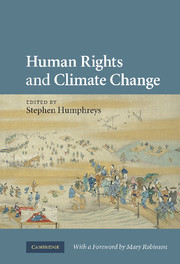Book contents
- Frontmatter
- Contents
- Authors' biographies
- Acronyms
- Acknowledgements
- Foreword
- Introduction: human rights and climate change
- PART I Rights perspectives on global warming
- PART II Priorities, risks and inequities in global responses
- 6 The Kyoto Protocol and vulnerability: human rights and equity dimensions
- 7 Forests, climate change and human rights: managing risks and trade-offs
- 8 Climate change and the right to the highest attainable standard of health
- 9 Human rights and vulnerability to climate change
- 10 Climate change, evolution of disasters and inequality
- Conclusion
- Appendix: climate change impacts on human rights
- Index
6 - The Kyoto Protocol and vulnerability: human rights and equity dimensions
from PART II - Priorities, risks and inequities in global responses
Published online by Cambridge University Press: 04 August 2010
- Frontmatter
- Contents
- Authors' biographies
- Acronyms
- Acknowledgements
- Foreword
- Introduction: human rights and climate change
- PART I Rights perspectives on global warming
- PART II Priorities, risks and inequities in global responses
- 6 The Kyoto Protocol and vulnerability: human rights and equity dimensions
- 7 Forests, climate change and human rights: managing risks and trade-offs
- 8 Climate change and the right to the highest attainable standard of health
- 9 Human rights and vulnerability to climate change
- 10 Climate change, evolution of disasters and inequality
- Conclusion
- Appendix: climate change impacts on human rights
- Index
Summary
Given the broad-based nature of climate change, the focus of law and policy has never been exclusively environmental. Economic and trade issues have, for instance, played a key role from the outset. While environmental and economic considerations have been central to the climate change legal regime, the same cannot be said for its human rights aspects.
The existing regime provides a number of entry points for the consideration of human rights. The notion of vulnerability is an effective starting point since it has been an important component of the regime since its inception. This important concept must, however, be given more specific content if it is to be effective in shaping the climate change regime in the future. Vulnerability applies both at the level of states and people. Concerning states, differential treatment already provides the conceptual basis for addressing vulnerability. However, the framework needs to be thought afresh to make it more effective at capturing the varying vulnerabilities of different developing countries as well as to take into account changed circumstances since the adoption of the Climate Change Convention (UNFCCC). Concerning people, the climate change regime needs to move beyond its traditional international environmental law model to encompass consideration of the specific vulnerabilities of individuals and communities. This is best achieved through the language of human rights that has already been widely discussed in environmental law contexts.
- Type
- Chapter
- Information
- Human Rights and Climate Change , pp. 183 - 206Publisher: Cambridge University PressPrint publication year: 2009
- 2
- Cited by



